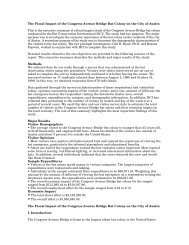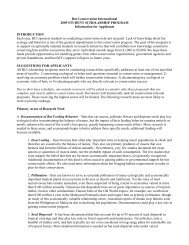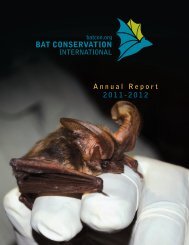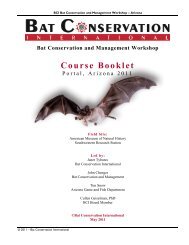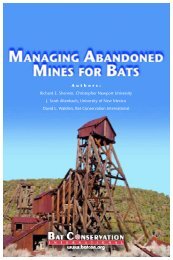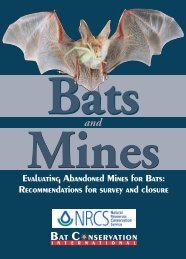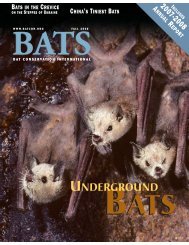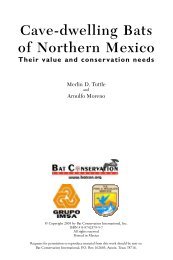Bat Echolocation Researc h - Bat Conservation International
Bat Echolocation Researc h - Bat Conservation International
Bat Echolocation Researc h - Bat Conservation International
You also want an ePaper? Increase the reach of your titles
YUMPU automatically turns print PDFs into web optimized ePapers that Google loves.
Section 2: Acoustic Inventories<br />
Figure 10: A mobile survey with a focus on what is perceived as ‘good’ bat habitat will lead to an assessment<br />
which is different from stationary set ups. The mobile approach will lead to a good cover of the batoccurrence<br />
landscape use in an area (A, C), whereas the stationary set up can provide detailed, quantitative<br />
data regarding the sample point (B, D). The observed spectrum of species might differ, where the<br />
mobile approach provides the opportunity to investigate particular habitats for target species.<br />
(Table 3, Fig 8). This summary<br />
can serve as a tool for selecting<br />
appropriate detectors. As examples<br />
at different ends of the spectrum<br />
of typical applications, questions<br />
that concern biogeography<br />
or the presence of a species in different<br />
habitats (upper left corner,<br />
Table 3, Fig. 8), require discriminative<br />
parameters of calls, but it is<br />
not necessary to identify all calls<br />
or to necessarily have the best<br />
characterization possible of call<br />
features. If large areas are to be<br />
surveyed, high mobility and several<br />
observers are needed, suggesting<br />
the need for multiple<br />
detectors of relatively low cost. In<br />
this situation, a successful<br />
approach could involve heterodyne<br />
detectors supported by<br />
some sets of TE or FD detectors<br />
for recording and back-up analysis<br />
(Fig. 9; Limpens et al. 1997).<br />
In contrast, questions about ecology and differences in<br />
echolocation calls within the context of how species fit<br />
into feeding guilds (upper right corner, Table 3, Fig. 8)<br />
demand high-quality recordings with the best acoustic<br />
information possible. Between the ‘extremes’ in the<br />
upper left and upper right corners of Table 3, different<br />
research approaches are possible. These approaches<br />
include surveys or transects with heterodyne detectors<br />
and combinations of heterodyne with FD or TE for<br />
back-up analysis (Limpens 1993; Walsh and Catto 1999;<br />
Walsh and Harris 1996a, 1996b), to setups with arrays of<br />
stationary systems involving TE, FD, or heterodyne<br />
detectors generating automated recordings on DAT or<br />
computer (Britzke et al. 1999; Jones et al. 2000).<br />
Where habitat use is the focus, a number of stationary<br />
detectors (i.e., sample points) may be the most<br />
appropriate. It is worth noting that an expensive detector<br />
at a fixed position will not monitor all habitats<br />
around the sample position equivalently, and sampling<br />
bias could lead to a different spectrum of species<br />
observed. Nor will the detector document differences in<br />
echolocation behavior in relation to flight patterns within<br />
various habitat features around the sampling point. In<br />
such cases, the use of stationary detectors on fixed sample<br />
points coupled with observers with the capability of<br />
TE recordings, would be complementary.<br />
Recent work demonstrates that studies of habitat use<br />
must take into consideration that bats use different strata,<br />
ranging from near the ground, to thousands of meters<br />
above the ground (Fenton and Griffin 1997; Griffin and<br />
Thompson 1982; McCracken 1996; Menzel et al. 2000).<br />
Because of the remote nature of altitudinal surveys, visual<br />
observation to enhance identification and tuning of<br />
the heterodyne system are difficult or impossible. Therefore,<br />
the use of broadband detectors is advisable.<br />
Although the detection range is limited, frequency-division<br />
systems seem most applicable to remote monitoring<br />
of bat activity because they are continuously monitoring<br />
the landscape. Where species identification is required,<br />
time-expansion systems may be preferred because they<br />
provide maximum information. In a time-expansion/heterodyne<br />
combination, the latter system continuously<br />
monitors the landscape, thus compensating for the timesampling<br />
and non-real-time performance required of the<br />
time-expansion system.<br />
In situations where bat activity is within, above, or<br />
near structures, such as roads, tunnels, wind power utility<br />
structures, caves, etc., relatively simple stationary<br />
automated setups with heterodyne detectors and signalactivated<br />
recorders can be effective, with the use of time<br />
expansion for back-up recording of high quality signals<br />
(e.g. Bach and Burkhardt 2000; Bach et al. 1999, 2001;<br />
Rahmel et al. 1999).<br />
Long-term observations are needed to document<br />
changes in activity patterns and trends over the course<br />
of seasons or years (Table 3, Fig. 8). Such studies might<br />
concentrate on where stationary setups are feasible.<br />
Where activity patterns and trends in populations in<br />
larger areas are involved, larger numbers of sample<br />
points, transects, or observers are needed. These characteristics<br />
require low profile and low cost approaches,<br />
where an accurate assessment of relative bat density<br />
rather than high-tech processing of sound is needed.<br />
Here again, heterodyne detectors, supported by some<br />
sets of time-expansion (or frequency-division) detectors<br />
for recording and back-up analysis can be a successful<br />
approach (Walsh and Harris 1996a, 1996b; Walsh and<br />
Catto 1999; de Wijs 1999).<br />
35



